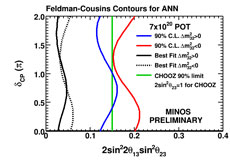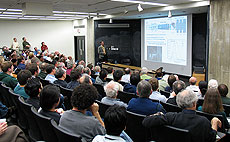MINOS continues the race
MINOS is used to neutrinos going missing. This time, the collaboration had hoped to find a few extra. The MINOS experiment collaboration presented a new result at Fermilab last week from an analysis that looked for one type of neutrino in a beam made up of another type. This new result constrains one of the unknown neutrino parameters, known as theta13, or θ13.
Scientists know that there are three types, or flavors, of neutrinos (muon, electron and tau). In the last decade, theyíve discovered that these particles have mass and they can switch between the different flavors. MINOS studies a beam of muon neutrinos created at the NuMI facility at Fermilab. Collaborators first measure those neutrinos at the experiment's near detector, located at Fermilab. From those measurements, collaborators predict how many of those muon neutrinos they should see in the far detector, located in northern Minnesota. It turns out that some of the muon neutrinos that scientists expect to see at the far detector donít show up. Those muon neutrinos are changing into a different flavor, or oscillating, on their way up north.
MINOS scientists expect the muon neutrinos that they produce to change predominantly into tau neutrinos on their journey, but a small fraction could change into electron neutrinos. Observing such a transformation would require a non-zero value of θ13, one of the few remaining unknown pieces of the physics governing neutrino oscillations. Several experiments are in the process of measuring or will soon measure θ13. Scientists are eager to observe such a transformation, as it could help answer existential questions regarding the abundance of matter over antimatter in our universe.
Up until now, the reactor neutrino experiment CHOOZ has provided the best information about the unknown parameter, θ13. Scientists on that experiment looked for the disappearance of electron anti-neutrinos. They did not observe any statistically significant deficit of the particles, so they set an upper limit on the value of θ13. MINOS uses a different technique to try to measure this parameter - looking for the appearance of electron neutrinos in a muon neutrino beam. MINOS is sensitive to smaller values of this parameter and has the potential to either measure the value of the parameter where CHOOZ could not, or could further constrain its value.
If θ13 is exactly zero, MINOS would expect to select 49.1 ± 7.0(stat.) ± 2.7(syst.) events in the far detector. If, instead, the parameter is just below the CHOOZ limit, there would be an additional 24 electron neutrino events in the far detector. When MINOS counted the selected events, they found 54 events, a result consistent with θ13=0. Even though scientists didnít observe the muon neutrinos changing into electron neutrinos, the new results narrow down the range of allowed values of the unknown oscillation parameters. The figure shows the values of the relevant oscillation parameters that are allowed after the MINOS result.
The race to measure θ13 continues!
Watch the MINOS talk at Fermilab.
View Patterson's slides from the talk.
-- Patricia Vahle
Result of the Week Archive
|
 |
| Values of the neutrino-mixing angles and the charge-parity violating phase that produce a number of candidate events in the MINOS far detector are consistent with the observation. Black solid lines show those values that best represent MINOS data if nature prefers the normal hierarchy neutrino mass and dotted lines show the values if nature prefers the inverted hierarchy. Values to the left of the blue lines are allowed at the 90 percent confidence level interval for the normal hierarchy, and red lines for the inverted hierarchy. The green line shows the CHOOZ upper limit. |
 |
| MINOS collaborator Ryan Patterson delivers a talk about the experiment's recent result on Friday at Fermilab. |
|